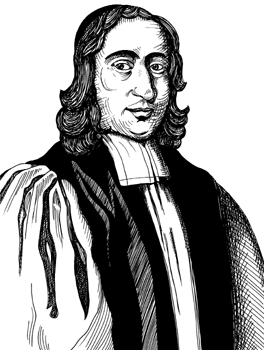 |
 |
|||
|
|
Francis
was the eldest son of Thomas
Turner (1591-1672), the Dean of Canterbury, by Margaret (1608-1692),
daughter of Sir Francis Windebank. He
was born on 23rd August 1637, traditionally at Reading
in Berkshire. Thomas Turner, President of Corpus Christi College, was his
younger brother. He was living at his maternal-uncle’s home in Hurst,
when he entered Winchester College in 1650. Francis
later proceeded to New College, Oxford, where he was admitted probationer-fellow
on 7th
November
1655. He graduated as a bachelor of arts on 14th
April
1659,
a master on 14th
January
1663
and was one of those who took the ‘engagement’ declaring their loyalty
to Parliament. Francis’
preferments were mainly due to the favour of the Duke of York, to whom he
was chaplain. On 30th December 1664, he was instituted to the rectory of
Therfield in Hertfordshire, succeeding John Barwick (1612-1664). On 17th
February 1665, he was incorporated at Cambridge and, on 8th May 1666, he was
admitted as a fellow commoner to St. John’s College, Cambridge, to which
he had been attracted by the possibility of patronage from Peter Gunning. He
compounded as a bachelor of divinity and a legum doctor at Oxford on 6th
July 1669. On 7th December1669, he was collated to the Prebend of Sneating
in St. Paul’s Cathedral. On 11th April 1670, he succeeded Gunning as
Master of St. John’s, Cambridge and it was during his incumbency that the
college's third court was completed. During this period, he also spent much
time at Therfield where he paid for the rebuilding of the chancel. He was
Vice-Chancellor in 1678 and resigned his mastership at Christmas 1679 in
order to follow the Catholic Duke of York to Scotland during his exile after
the Popish Plot. He had been selected as chaplain to the Anglicans in his
household and acted as an intermediary between the Duke and both the English
and Scottish establishment. By 1681, he was performing a similar role
between the Duke and the Commission for Ecclesiastical Promotions who were
seeking out disreputable clerics under the direction of Henry
Hyde, 2nd Earl of Clarendon. Not surprisingly, Turner became a
beneficiary of the commission’s work, trading in Therfield for Great
Haseley in Oxfordshire and then being installed as Dean of Windsor
on 20th July 1683. He was consecrated Bishop of Rochester,
at Lambeth Palace, on 11th November the same year, holding his deanery in
commendam, with the office of Lord Almoner, because his diocese was so
impoverished. On 16th July 1684, he was translated to the Bishopric of Ely
(confirmed 23rd August) in succession to Gunning, who had made him one of
his literary executors. He preached the sermon at the Duke of York’s
coronation as King James II on 23rd April 1685, and, in the following July,
prepared Monmouth for his execution. However,
Turner’s relationship with the new king cooled as his pro-Catholic
religious policies took shape and the Archbishop of Canterbury was banished
from court. When the King issued his Declaration of Indulgence which granted
freedom of worship to Catholics and other dissenters, it was Turner who
organised the opposition of the London parish clergy. Then, on 18th May
1688, he joined the Petitionary Protest of the Seven Bishops. The bishops were imprisoned and prosecuted but soon
acquitted to the great delight of the populace. Turner regretted the damage
this caused to King James’ position, and refused to support the invasion
of his son-in-law, William of Orange. When the King fled London on 10th
December, Turner and the Earl of Rochester called a provisional government
of twenty-nine peers to meet at Guildhall. They issued a declaration
unfavourable to James, but still lukewarm towards William. Turner then
headed a deputation of bishops who tried to persuade James to compromise and
return, but the King fled the country on 23rd December. Bishop
Turner declined the oath of allegiance to William and Mary, and hence
incurred suspension from office on 1st August 1689. His diocese was
administered by a commission consisting of Compton, Bishop of London, and
Lloyd, Bishop of St. Asaph. On 1st February 1690, he was deprived of his
bishopric. He was in correspondence with King James and professed to write
“in behalf of my elder brother, and the rest of my nearest relations, as
well as for myself” (meaning Archbishop Sancroft and the other nonjuring
bishops). A proclamation for his arrest was issued on 5th February 1691,
but he kept his head down and, on 24th February 1693, he was able to join
the nonjuring bishops, Lloyd and White, in consecrating George Hickes and
Thomas Wagstaffe
as suffragans of Thetford and Ipswich, the object being to continue a
succession in the Jacobite interest. The 2nd Earl of Clarendon, was present
at the ceremony, which took place at White’s Lodging. In 1694, it was
proposed that Turner, who was in easy circumstances, should be invited to
St. Germains to attend upon King James, a proposal which the former
monarch approved but did not carry out. On 15th December 1696, Turner was
arrested, but discharged on condition that he leave the country. On 26th
December, he was rearrested. No more is heard of him till his death, which
occurred in London on 2nd November 1700. He was buried on 5th November in
the chancel at Therfield Church. On 18th October 1676, he was married by
Gunning (then Bishop of Ely), at Ely House Chapel in London, to Anna
daughter of Walter Horton of Catton in Derbyshire. She died in childbirth,
aged twenty-six, on 28th January 1678. His intestacy gave all his effects to
his daughter Margaret (d. 25th December 1724), wife of Richard Goulston of
Widdihall in Hertfordshire, thus disappointing the expectation of bequests
to St. John’s College, of which he had already been a benefactor. Edited from Sidney Lee's 'Dictionary of National Biography' (1899).
|
|||
| © Nash Ford Publishing 2009. All Rights Reserved. | ||||



 Francis Turner (1637-1700)
Francis Turner (1637-1700)